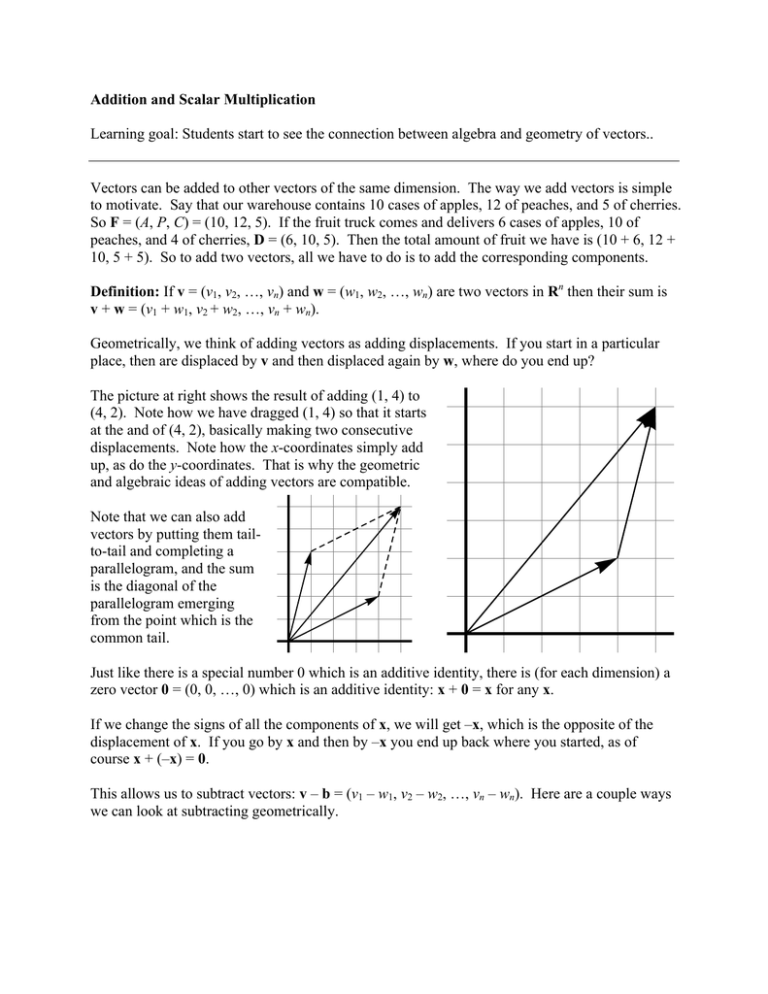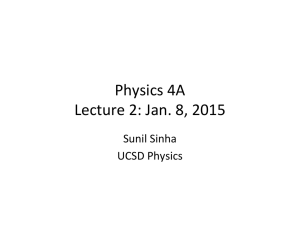Notes 05--Vector Arithmetic
advertisement

Addition and Scalar Multiplication Learning goal: Students start to see the connection between algebra and geometry of vectors.. Vectors can be added to other vectors of the same dimension. The way we add vectors is simple to motivate. Say that our warehouse contains 10 cases of apples, 12 of peaches, and 5 of cherries. So F = (A, P, C) = (10, 12, 5). If the fruit truck comes and delivers 6 cases of apples, 10 of peaches, and 4 of cherries, D = (6, 10, 5). Then the total amount of fruit we have is (10 + 6, 12 + 10, 5 + 5). So to add two vectors, all we have to do is to add the corresponding components. Definition: If v = (v1, v2, …, vn) and w = (w1, w2, …, wn) are two vectors in Rn then their sum is v + w = (v1 + w1, v2 + w2, …, vn + wn). Geometrically, we think of adding vectors as adding displacements. If you start in a particular place, then are displaced by v and then displaced again by w, where do you end up? The picture at right shows the result of adding (1, 4) to (4, 2). Note how we have dragged (1, 4) so that it starts at the and of (4, 2), basically making two consecutive displacements. Note how the x-coordinates simply add up, as do the y-coordinates. That is why the geometric and algebraic ideas of adding vectors are compatible. Note that we can also add vectors by putting them tailto-tail and completing a parallelogram, and the sum is the diagonal of the parallelogram emerging from the point which is the common tail. Just like there is a special number 0 which is an additive identity, there is (for each dimension) a zero vector 0 = (0, 0, …, 0) which is an additive identity: x + 0 = x for any x. If we change the signs of all the components of x, we will get –x, which is the opposite of the displacement of x. If you go by x and then by –x you end up back where you started, as of course x + (–x) = 0. This allows us to subtract vectors: v – b = (v1 – w1, v2 – w2, …, vn – wn). Here are a couple ways we can look at subtracting geometrically. �+� � �-� � � � -� � � -� �-� First we show v and w and –w. Then we show the explicit addition of –w to v to find v – w. The final picture shows v and w tail-to-tail, and v – w is the vector running from the tip of w to the tip of v, because (v – w) is just what you need to add to w to end up at v. There are some familiar algebraic properties of vector addition: • It is commutative: v + w = w + v • It is associative: (v + w) + x = v + (w + x) These are easily proven algebraically by looking one component at a time where we just are asking about the same property of addition for the real numbers. We could also prove these geometrically, by noting that the parallelogram used to add v and w doesn’t care which comes first, and that we can group our displacements any way—a trip of three steps is the same trip whether I take the first two today and the third tomorrow, or the first today and the last two tomorrow. There is another piece of vector arithmetic, called scalar multiplication. What happens if you get three of those fruit deliveries? Well, we’d have to add (3⋅6, 3⋅10, 3⋅5) to our amount of fruit. We will say that this is 3D: Definition: if v = (v1, v2, …, vn) is a vector in Rn and c is a real number we can form the scalar multiple cv = (cv1, cv2, …, cvn). We call this the “scalar” multiple because c’s job is to scale the size of v without changing its direction. That is, if you think of a vector v as a displacement, then cv is a displacement c times as far in the same direction. This makes sense, because cv = (cv1 )2 + (cv2 )2 +!+ (cvn )2 = c 2 (v12 + v2 2 +!+ vn 2 and we can factor out the common term to get c 2 v12 + v2 2 +!+ vn 2 = c v . So the length of cv is c times that of v (or opposite of that if c is negative—that absolute value is important!). Furthermore, let c = 1/||v||. From the above calculation, the length of cv is one. It is a unit vector, which we think of as the direction of v, v̂ . So we have the equation 1 v = v̂ or v = v v̂ . v Vectors don’t just have length and direction. The are their length times their direction! The following rules of arithmetic involving vector addition and scalar multiplication can be proved as before—either through checking each component, or by seeing how the pieces fit together geometrically: • (ab)v = a(bv) • 1v = v and (–1)v = –v • (a + b)v = av + bv • a(v + w) = av + aw A simple example of all this is something we do all the time—break a vector into its components. For instance, (6,2,−3) = 6 î + 2 ĵ + (−3)k̂ . One last combination of things we haven’t looked at yet. How does vector addition work with lengths? We’ll prove it later, but the answer is that we have the triangle inequality: • ||v + w|| ≤ ||v|| + ||w||, and equality only happens when v and w have the same direction (or when one or both equal zero—the zero vector does not have a direction!)

